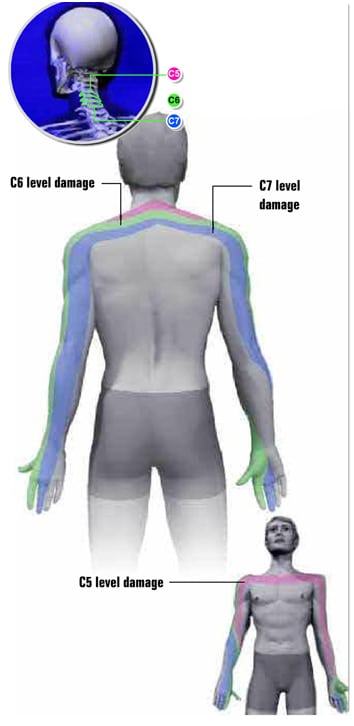Cervical Radiculopathy
A Cervical Epidural Steroid Injection is a Pain Management procedure used for treating Cervical Radiculopathy or neck pain and radiating shoulder and arm pain. The procedure provides pain relief by reducing the inflammation and swelling of the nerve roots as they exit your spine.
The nerve roots that leave your neck area serve your arms. If you injure a cervical nerve root, you may feel pain, weakness, numbness or tingling in your shoulder or arm.
A Cervical Epidural Steroid Injection deposits local anesthetic and steroid medication into the epidural space of your spine, right at the injured cervical nerve root. The epidural space is located just outside of the protective sac containing your spinal fluid.
 CAUSES OF CERVICAL RADICULOPATHY
CAUSES OF CERVICAL RADICULOPATHY
Your spinal cord branches out to all parts of your body. The part of a nerve that connects to the spinal cord is called a nerve root. If one of these roots is injured or pinched, you may feel pain, weakness, numbness or tingling in the part of the body served by that nerve.
In the case of a cervical or neck-area nerve, you likely will feel the effects in your neck, shoulder or arm. The pain or numbness usually affects just one side of your body. Below are some causes for the damaged nerve:
HERNIATED DISC
When a spinal disc ruptures, as is the case from a herniated disc, the disc material may press on a nerve root, causing you pain.
If you have spinal stenosis, the bones surrounding your spinal canal grow inward, pinching a nerve root. This is another painful condition.
If a spinal disc weakens, vertebral bones above and below may move closer together or even touch. If this happens, as it does if you have degenerative disc disease, the vertebrae may pinch nearby nerve roots. Bony spurs of the vertebrae also may press on the nerves.
PREPARATION FOR A CERVICAL EPIDURAL STEROID INJECTION
This procedure usually takes only a few minutes. Before the procedure, your doctor numbs your skin where he or she will make the injection. Your doctor will use lidocaine, which is similar to the novocaine that dentists use. Lidocaine is a local anesthetic, numbing only the area where it’s applied.
Your doctor uses a fluoroscope, which provides live X-ray images, to guide the needle accurately. Once your doctor has the needle where it needs to be, he or she injects the steroid medication.
Following the injection, you’ll be monitored for 15 to 20 minutes before being discharged to go home. On the day of your Cervical Epidural Steroid Injection, you have to rest. The day after your injection, you usually can resume your normal activities — those that you’ve done the week prior to the injection.
MORE INFORMATION
For more information about nerve blocks and epidurals, refer to SSI’s Block Suite.
Find out more about SSI’s Pain Management procedures.
